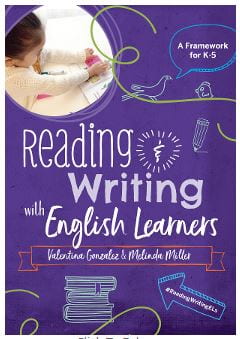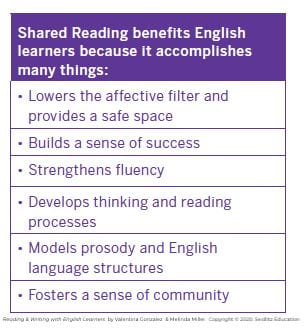Editor’s Note: Valentina Gonzalez and Melinda Miller have written a terrific book, and they’ve agreed to let me publish an excerpt here. I’ll also be sharing an interview with them in my Education Week column after the first of the year.
“There’s so much more to a book than just reading.” Maurice Sendak
WHAT IS SHARED READING?
Shared reading is a method of involving the whole class in reading a text together. In shared reading, everyone has access to the same text, which they read together as the teacher leads the way. Typically, the text is read repeatedly over multiple days, focusing on various teaching points.
In primary classrooms, shared reading may come in the form of a big book that the teacher displays in front of students as they gather at a common reading area. Teachers may focus more on print, letter sounds, and the foundations of reading.
Shared reading in upper elementary classrooms may look slightly different. The teacher may display a text under a document camera for all to see, or each student could have a copy of the text. Teachers may then focus on closer analysis of this text.
I was reminded of the effectiveness of shared reading while attending a holiday concert where the choir director led us in what I considered to be a variation of shared reading of the song he was singing. Picture this: The words were scrolling on the big screen for us all to see. As he was singing, each word was highlighted. He encouraged us to join in by shouting, “Come on, now!” and beckoning us with his arms. As we joined, he pointed the mic at us. Occasionally, when a new and more challenging part was coming up, he said, “The next line goes like this…” and he modeled it for us before it came on the screen. This was his way of employing echo reading (See p. 115). He led the way by example, his expressions and tone helping us to know better how to sing each additional verse. -Valentina
Shared reading provides an opportunity for all students to put their eyes on the same text and practice reading together under the careful supervision and guidance of the teacher. The guided instruction and modeling provided by the teacher in shared reading supports students to be successful on their own.
Shared reading is used as a vehicle of instruction. We need students to gain certain reading and thinking practices or goals, such as learning phonics using authentic text or learning to make predictions. Shared read-ing helps us get them there by ensuring that they actively participate in reading, speaking, and thinking using a text that is slightly higher than their instructional level. When ELs at beginning and intermediate levels of proficiency are provided with sufficient background information, shared reading can even be a significant source of comprehensible input.
WHAT SHARED READING IS NOT
Though shared reading is often seen in the younger grades, it is not only for primary classrooms. Even students in grades three and up benefit from shared reading. In older grades, shared reading may not look the same, but the value is still as great. Older students still need to practice reading on grade level in a safe environment in which they are free to take risks. Thus, shared reading opens a space for low-risk reading that includes every kind of learner in the classroom.
Shared reading can be used for more than just fiction. In fact, bringing in biographies, poetry, comics, daily news, captions, how-to instructions, and other materials that are en-gaging and relevant to students will greatly enhance their reading pleasure and stretch their vocabularies. Shared reading can be done with shorter readings or more lengthy pieces.
There is a misconception that shared reading is only for whole-group instruction. This is not the case. Shared reading can be implemented in small groups, too. Many students benefit from a smaller, more inti-mate setting, and the lower student-teacher ratio can support students who need more tailored interventions. Some English learners at lower proficiency levels may gain more from shared reading in small groups than they would with the whole class.
THE BENEFITS OF SHARED READING FOR ENGLISH LEARNERS
Shared reading can support students by providing a nice foundation for the way letters, sounds, and words work together. All students can benefit from the shared reading experience, but English learners especially make great gains from the structure of reading together as a group.
Shared reading is an opportunity to directly teach intonation, language structures, and fluency. Author Kylene Beers (2003) says, “It’s one thing to model fluent reading and another to directly teach students how to use correct phrasing and intonation”
(p. 216).
If you liked what you read and want more on shared reading, other components of literacy, and how to support English learners with language and literacy, you can find more in our book Reading & Writing with English Learners or visit the Reading & Writing with English Learners website.






Recent Comments